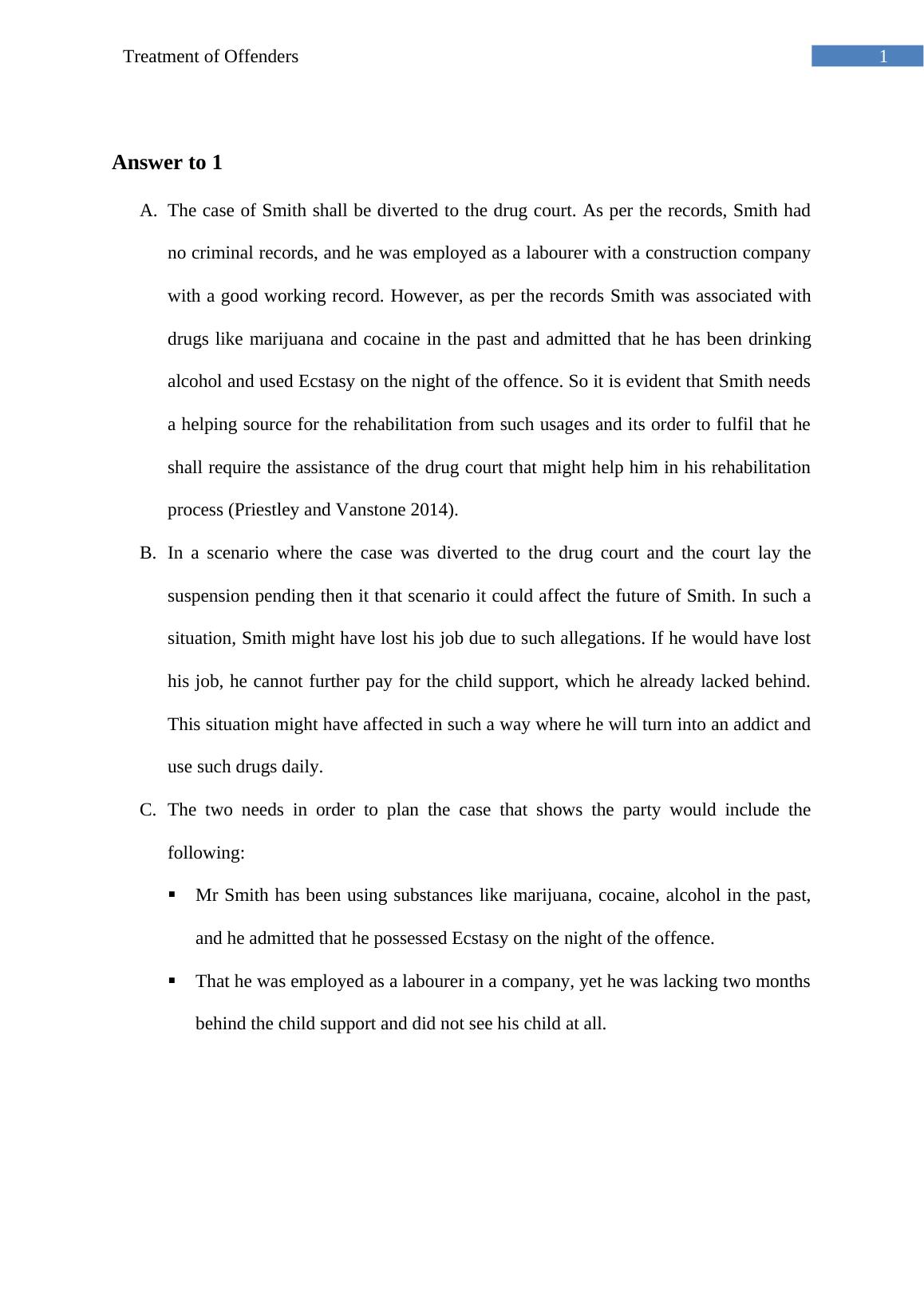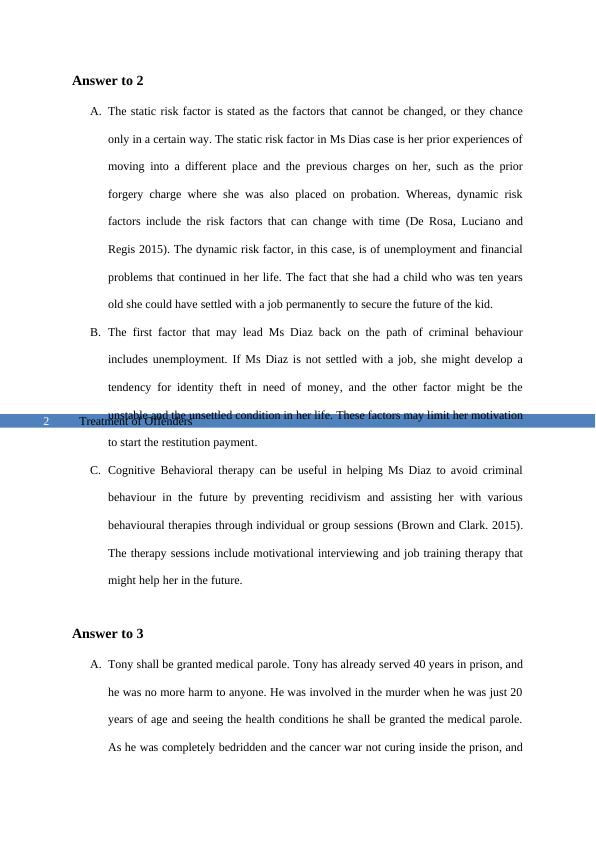Treatment of Offenders - Case Studies
Added on 2022-08-12
8 Pages1780 Words23 Views
Running head- TREATMENT OF OFFENDERS
Treatment of Offenders
Name of the Student
Name of the University
Author Note
Treatment of Offenders
Name of the Student
Name of the University
Author Note

Treatment of Offenders1
Answer to 1
A. The case of Smith shall be diverted to the drug court. As per the records, Smith had
no criminal records, and he was employed as a labourer with a construction company
with a good working record. However, as per the records Smith was associated with
drugs like marijuana and cocaine in the past and admitted that he has been drinking
alcohol and used Ecstasy on the night of the offence. So it is evident that Smith needs
a helping source for the rehabilitation from such usages and its order to fulfil that he
shall require the assistance of the drug court that might help him in his rehabilitation
process (Priestley and Vanstone 2014).
B. In a scenario where the case was diverted to the drug court and the court lay the
suspension pending then it that scenario it could affect the future of Smith. In such a
situation, Smith might have lost his job due to such allegations. If he would have lost
his job, he cannot further pay for the child support, which he already lacked behind.
This situation might have affected in such a way where he will turn into an addict and
use such drugs daily.
C. The two needs in order to plan the case that shows the party would include the
following:
Mr Smith has been using substances like marijuana, cocaine, alcohol in the past,
and he admitted that he possessed Ecstasy on the night of the offence.
That he was employed as a labourer in a company, yet he was lacking two months
behind the child support and did not see his child at all.
Answer to 1
A. The case of Smith shall be diverted to the drug court. As per the records, Smith had
no criminal records, and he was employed as a labourer with a construction company
with a good working record. However, as per the records Smith was associated with
drugs like marijuana and cocaine in the past and admitted that he has been drinking
alcohol and used Ecstasy on the night of the offence. So it is evident that Smith needs
a helping source for the rehabilitation from such usages and its order to fulfil that he
shall require the assistance of the drug court that might help him in his rehabilitation
process (Priestley and Vanstone 2014).
B. In a scenario where the case was diverted to the drug court and the court lay the
suspension pending then it that scenario it could affect the future of Smith. In such a
situation, Smith might have lost his job due to such allegations. If he would have lost
his job, he cannot further pay for the child support, which he already lacked behind.
This situation might have affected in such a way where he will turn into an addict and
use such drugs daily.
C. The two needs in order to plan the case that shows the party would include the
following:
Mr Smith has been using substances like marijuana, cocaine, alcohol in the past,
and he admitted that he possessed Ecstasy on the night of the offence.
That he was employed as a labourer in a company, yet he was lacking two months
behind the child support and did not see his child at all.

Treatment of Offenders2
Answer to 2
A. The static risk factor is stated as the factors that cannot be changed, or they chance
only in a certain way. The static risk factor in Ms Dias case is her prior experiences of
moving into a different place and the previous charges on her, such as the prior
forgery charge where she was also placed on probation. Whereas, dynamic risk
factors include the risk factors that can change with time (De Rosa, Luciano and
Regis 2015). The dynamic risk factor, in this case, is of unemployment and financial
problems that continued in her life. The fact that she had a child who was ten years
old she could have settled with a job permanently to secure the future of the kid.
B. The first factor that may lead Ms Diaz back on the path of criminal behaviour
includes unemployment. If Ms Diaz is not settled with a job, she might develop a
tendency for identity theft in need of money, and the other factor might be the
unstable and the unsettled condition in her life. These factors may limit her motivation
to start the restitution payment.
C. Cognitive Behavioral therapy can be useful in helping Ms Diaz to avoid criminal
behaviour in the future by preventing recidivism and assisting her with various
behavioural therapies through individual or group sessions (Brown and Clark. 2015).
The therapy sessions include motivational interviewing and job training therapy that
might help her in the future.
Answer to 3
A. Tony shall be granted medical parole. Tony has already served 40 years in prison, and
he was no more harm to anyone. He was involved in the murder when he was just 20
years of age and seeing the health conditions he shall be granted the medical parole.
As he was completely bedridden and the cancer war not curing inside the prison, and
Answer to 2
A. The static risk factor is stated as the factors that cannot be changed, or they chance
only in a certain way. The static risk factor in Ms Dias case is her prior experiences of
moving into a different place and the previous charges on her, such as the prior
forgery charge where she was also placed on probation. Whereas, dynamic risk
factors include the risk factors that can change with time (De Rosa, Luciano and
Regis 2015). The dynamic risk factor, in this case, is of unemployment and financial
problems that continued in her life. The fact that she had a child who was ten years
old she could have settled with a job permanently to secure the future of the kid.
B. The first factor that may lead Ms Diaz back on the path of criminal behaviour
includes unemployment. If Ms Diaz is not settled with a job, she might develop a
tendency for identity theft in need of money, and the other factor might be the
unstable and the unsettled condition in her life. These factors may limit her motivation
to start the restitution payment.
C. Cognitive Behavioral therapy can be useful in helping Ms Diaz to avoid criminal
behaviour in the future by preventing recidivism and assisting her with various
behavioural therapies through individual or group sessions (Brown and Clark. 2015).
The therapy sessions include motivational interviewing and job training therapy that
might help her in the future.
Answer to 3
A. Tony shall be granted medical parole. Tony has already served 40 years in prison, and
he was no more harm to anyone. He was involved in the murder when he was just 20
years of age and seeing the health conditions he shall be granted the medical parole.
As he was completely bedridden and the cancer war not curing inside the prison, and

End of preview
Want to access all the pages? Upload your documents or become a member.
Related Documents
Stewart v Elk Valley Coal Corp., 2017 SCC 30lg...
|5
|863
|457
Decision on Heart Transplant Surgery for Lisalg...
|3
|829
|147
